
St. Bernadette Church’s beautified interior meant to draw faithful closer to Christ
By Tony Gutiérrez, The Catholic Sun
SCOTTSDALE – Not paying attention to the Scripture readings or homily might be forgiven at St. Bernadette Parish in North Scottsdale. It’s easy to be captivated by the beauty of the newly installed art inside the church, that in itself serves a homiletic purpose.
“Before the formal written Catechism, the way that [the Church] would catechize would be through art,” said the Very Rev. Don Kline, pastor of St. Bernadette and vicar forane of the diocese’s Northeast Deanery.
St. Bernadette was established as a parish in 1995, but it did not have a permanent worship space until 2016 and wasn’t dedicated until May 25, 2017. The late Father Pete Rossa, who was pastor at the time, wanted to build a beautiful church. It was built with a cruciform footprint and Romanesque architecture that allowed for good acoustics. The French influence is noticeable, a nod to the parish’s patroness.
“If I were to die tomorrow, it would be my sincerest hope not that I be remembered for this church, but that I would be remembered for bringing you closer to Jesus Christ because that is our mission, that is our hope, that is our longing at the core of our faith,” Fr. Rossa said at the time the church was opened. He died just over a year later, on Sept. 13, 2017. While much of the interior remained bare, it had been Fr. Rossa’s vision to continue to beautify the church.
“It’s so, so beautiful, and it’s such a great tribute to Fr. Pete, who first had the idea that we really needed to have beauty in order to evangelize today. He was so convinced of that,” Bishop Thomas J. Olmsted told the Sun in an interview. “He built the church, but this was all waiting to be done. So, I’m so grateful that Fr. Kline has carried through with such fidelity to the original vision, but we didn’t imagine it would be even more beautiful than we thought.”
Zabinia Arvizu, a 19-year-old student at Arizona State University in Tempe who also attends All Saints Newman Center that serves the school, grew up as a parishioner at St. Bernadette. Both she and her boyfriend, 20-year-old ASU student Patrick Kossler from St. Timothy Parish in Mesa, were struck by the beauty of the church.
“Every time that I step into this church, I fall in love with the faith all over again. It’s just such a beautiful reminder of the beauty of God and how He works in people’s lives,” said Arvizu. “Seeing how many people that the church has brought in, and just seeing how beauty really does reflect God and draw us closer to Him is so powerful to me.”
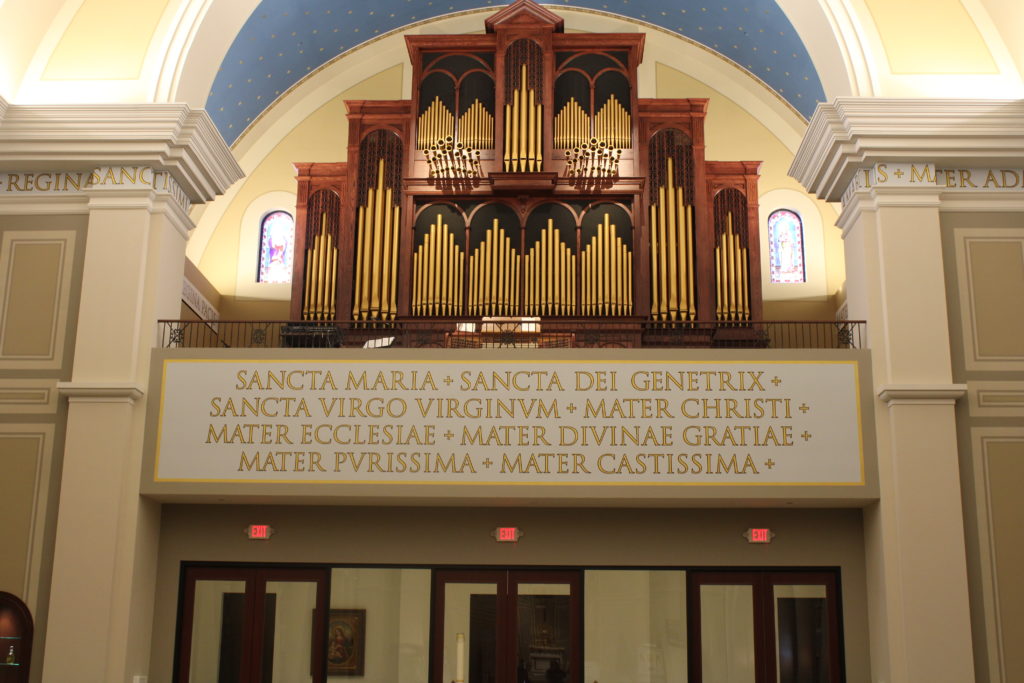
Sacred Music as Sacred Art
Bishop Olmsted paid a pastoral visit to St. Bernadette on Dec. 19, 2021, the Fourth Sunday of Advent, to see the new art and dedicate a new organ, which was part of the beautification project. In his homily, he referenced a 1999 article in the Catholic apologetics journal This Rock titled “I Was Converted by Mozart.” In it, the author, Eric M. Johnson, describes beauty as what brought him to the Church.
“‘It was through music and art that I encountered a positive, inspiring vision of Catholicism. … It was through my ears and eyes that I first became attracted to the faith,’” Bishop Olmsted quoted Johnson as writing. “It was sacred music that turned this man towards God, lifting him above confused thinking and attuning his soul to the Lord,” the bishop commented.
Standing in the choir loft at 300 square feet, the organ was assembled by Peragallo Organ Company. With 3,000 pipes, it functions using natural acoustics rather than electricity.
“It’s really just out of this world. It’s so much fun to get to sing with it, and I don’t know how to put it into words,” said Brina Ziemann, who has served as music director for three years.
She noted that from the choir loft she can see the apse, a hemispherical semi-dome above the altar, that features a replica of “The Immaculate Conception” by Italian Rococo painter Giovanni Battista Tiepolo.
“When the organ is playing the ‘Ave Maria’ by Schubert, and I get to look at her as I’m singing it, it’s like I’m singing just to her, and it’s beautiful,” she said.
Her husband, Ben Ziemann, sings bass in the choir and described how using his gift in the newly adorned church affected him.
“Singing in such a beautiful place, you just get overwhelmed with tears and emotions at times,” he said.
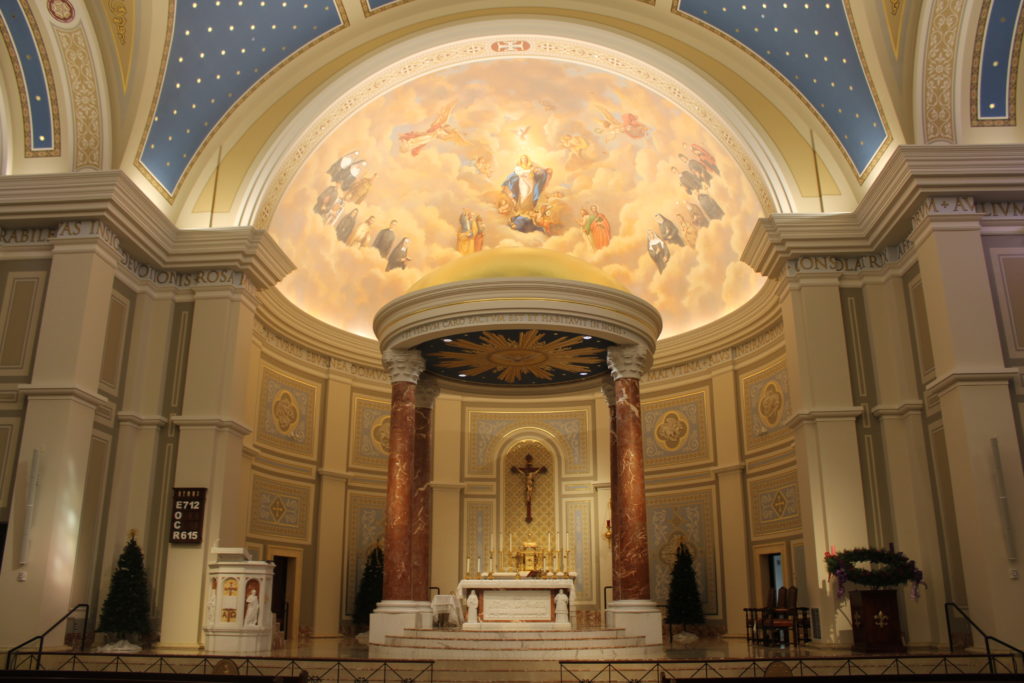
Cloud of Witnesses
In addition to the Blessed Virgin depicted in the apse, on either side of her are angels, saints and blesseds, including all of those canonized and beatified from the United States — the only such artistic collection of all of them together in the diocese, and possibly the nation, including the most recently beatified [October 2020] — Bl. Michael J. McGivney, founder of the Knights of Columbus. They are all surrounded by clouds as if joining in the liturgy from heaven.
“It literally looks like you’re entering heaven itself, and the liturgy itself brings us into heaven,” Bishop Olmsted told the Sun in describing the apse. “We’re one with the liturgy in heaven.”
For Eveling Ortega, who has been a parishioner since she attended the attached St. John XXIII School in the 1990s, this rendition is the most impactful to her because it reminds her of her own call to holiness.
“It’s a representation of heaven and of what we want to obtain,” said Ortega in Spanish. “It’s something that I want for me, too, but more importantly, for all of family, my loved ones and the entire world, that we can all be there.”
That’s the type of perspective that Fr. Kline had hoped for in highlighting those from our country who’ve been elevated by the Church.
“So much of our culture has just dumbed things down to the bare minimum. There are great conversations to be had about incredible people who have lived among us, and we wanted to be able to help people start the conversation by depicting some of the greats who walked among us who were just like us in many ways, so we can relate,” he said. “It gives us hope, saying, ‘Maybe I got a shot. Maybe I could become one of those saints.’”
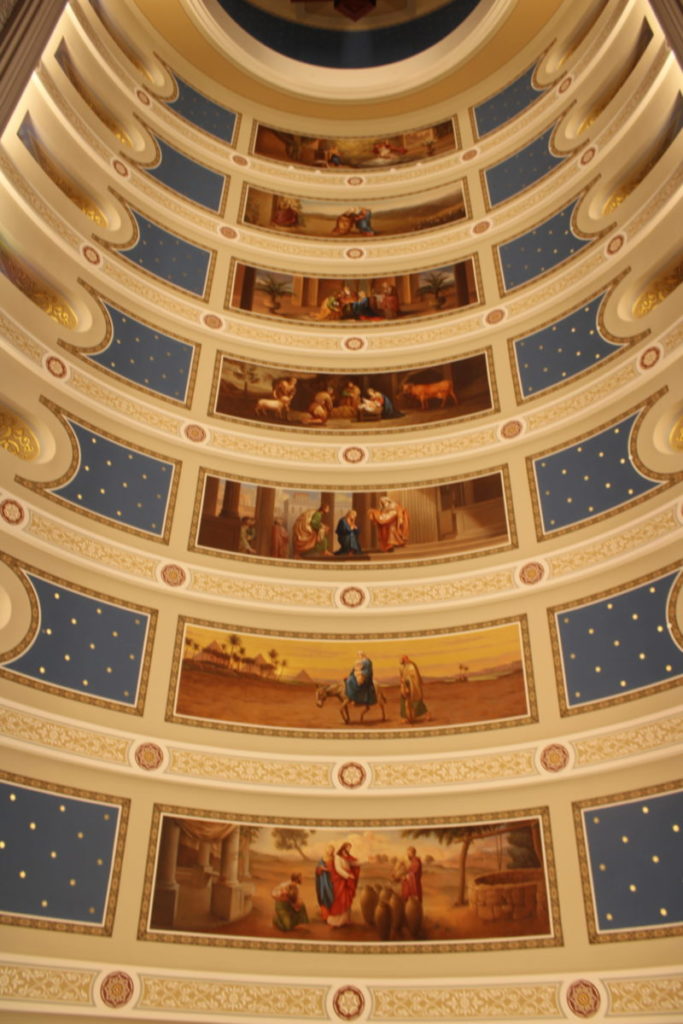
Drawn to Heaven
Reminiscent of the painted churches of Central Europe and of immigrants from there, the ceiling is painted blue with a field of stars, meant to make the visitor think of Heaven.
“It’s a very typical traditional way of depicting the celestial, the heavenly,” said Fr. Kline. “The church, the high ceilings, everything is meant to really direct us or point us to heaven, to God, the things of God. That’s why down below, you see less art, but it’s meant to carry your eyes up to the heavens.”
Above the Communion rail is a painting of the Holy Trinity — God the Father holding a post-crucifixion Jesus, with a dove representing the Holy Spirit flying underneath the Father’s arm.
“For me, that’s the most important, because it’s our Father, our Redeemer, our Savior, where we want to go, Heaven,” said Eveline’s mother, Janneth Ortega, in Spanish.
Just above the altar, the Holy Spirit in the form of a dove can be seen on the underside of the baldacchino, which calls to mind the priest calling Him down when consecrating the Eucharist. Esther Keeley, who was visiting her daughter’s family from Fair Oaks Ranch, Texas, during that weekend, shared how the beauty overwhelmed her.
“When I went up to receive Communion and knelt at the altar, I was overwhelmed, and tears just started brimming up in my eyes. I couldn’t control it,” said Keeley, who attends St. Peter the Apostle Parish in Boerne in the Archdiocese of San Antonio. “I was struggling to control it, but I was overwhelmed with the beauty of the church, of everything, of the altar, of the Holy Spirit over the altar. It’s amazing.”
Dcn. Peter Auriemma, who studied art history in Rome and serves as a docent for the church, reflected on assisting in the liturgy in the updated sanctuary.
“When the priest calls down the Holy Spirit, as deacon up there, I’m ringing the bell, and I can’t help but look up and see the image of the Holy Spirit right above, coming down,” he said. “It’s an unspeakable blessing to be a part of this.”
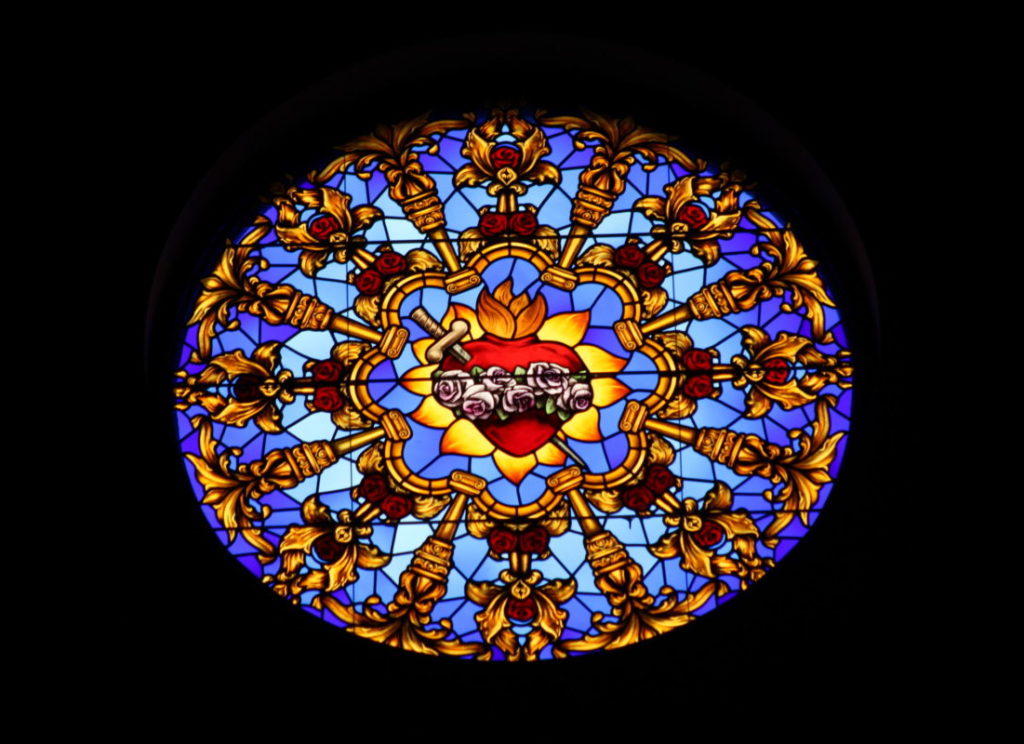
Beauty offers hope
The plans to beautify the interior was initially intended for just the apse, but it incrementally flowed from there to the nave of the church, including the ceiling. Before the project began, Fr. Kline organized a prayer team to spend time in Adoration.
“It was all wrapped in a mantle of prayer from the very beginning,” he said, noting that the COVID-19 pandemic had just begun around the same time. “When we started this project, it was the beginning of the pandemic. We thought people need to have some kind of hope in the midst of this terrible time in people’s minds. That also was pushing us to say, ‘How can the Lord use us to bring a little bit of hope in a time when it seems to be difficult to find?’”
Noting the ugliness of the pandemic, Bishop Olmsted thanked parishioners for choosing to focus on beauty, instead.
“You chose instead to focus on beauty; for what is ugly tires the human spirit and corrodes the heart,” he said. “On the other hand, beauty endures into eternity as it expands to infinite proportions. It will last forever in the presence of God.”
The project had been planned for approximately a year-and-a-half. The church closed May 15, and parishioners met in the original worship space which is now used as a parish hall. At any given point, there were more than 50 different artists working at different sections of the church — one company designed the stained glass windows, one person painted a large rendition of St. Bernadette encountering Our Lady of Lourdes, yet another painted the Stations of the Cross placed throughout the church, etc. But God, said Fr. Kline, was the “master artist” of the project.
“There were so many moments where we were just like, ‘How did that happen?’ It was so beyond anything we could have imagined. We were just so excited to see what God was going to do next, because it really was beyond all of us,” said Fr. Kline. “The artists would all say the same thing, ‘This is the most incredible work we’ve ever been a part of,’ and how they were themselves inspired beyond anything they could have imagined. So, they, too, felt this is something bigger than us.”
The total cost of the project was just less than $3 million. Part of the funding came from the “Together Let Us Go Forth ~ Juntos Sigamos Adelante” campaign, primarily for the bells and part of the stained glass windows. There was no other campaign; rather, the parish relied on the generosity of donors.
“We were very blessed to be able to have generous, anonymous donors, often time, who just gave towards the project and still are,” said Fr. Kline. “People will pay for beauty. When they’re inspired, they believe in the project, they will get behind it. People would just come forward and say, ‘Father, we want this to happen. How can we help?’”
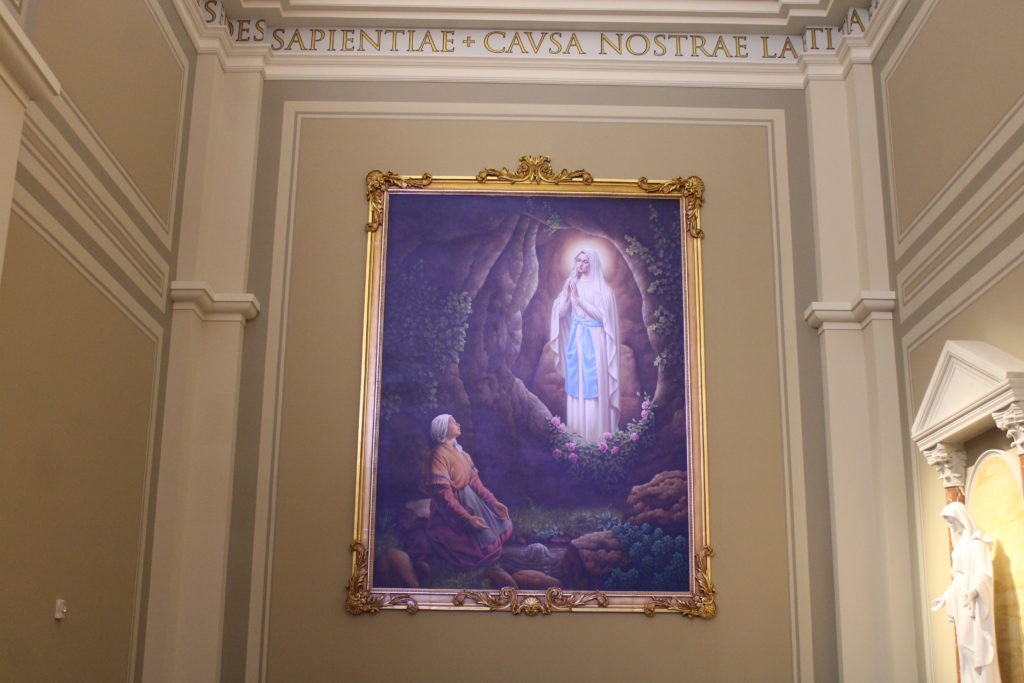
Honoring parish patroness
Featured prominently in the Gospel — or left — wing of the church, which is typically dedicated to the Blessed Mother, is a life-size painting of Our Lady of Lourdes appearing to St. Bernadette Soubirous — the parish’s patroness — as a 14-year-old peasant girl in 1858. It is illuminated by a spotlight from the opposite wing. A painting of the Holy Family by the same artist is planned to be installed on the Epistle — or right — wing.
Martín Perez, who was part of the Knights of Columbus Fourth Degree honor guard from Our Lady of the Rosary Assembly 2374 serving the parishes of St. Bernadette, Blessed Sacrament and St. Bernard of Clairvaux, all in Scottsdale, and St. Joseph in North Phoenix, said he was honored to serve, adding that he was particularly touched by the painting.
“The portrait of St. Bernadette has been very illuminating to me,” said Perez, who is also a past grand knight and current trustee for the parish’s Council 12164. “It just sticks out. It almost feels like you’re in real time when you look at it.”
Also on the ceiling are episodes in the life of the Blessed Mother, and on the walls encircling the perimeter of the church is the Marian Litany of Loreto, written in Latin, which is still the official language of the Church. A statue of Our Lady of Lourdes that used to stand atop the baldacchino in the sanctuary will be used to build a replica of the grotto to her found in Lourdes, along with a forthcoming statue of St. Bernadette.
“There’s nothing like it here that I’ve found the United States, certainly not in Arizona that depicts it the same way again,” remarked Fr. Kline. “People will have to travel to France in order to see this scene, and we’re going to bring it right here to Scottsdale, Arizona.”
The Marian nature of the church honors St. Bernadette’s role as the visionary of Our Lady revealing herself as the Immaculate Conception, and the saint once referred to herself as a “broom” to be used by the Blessed Virgin.
“People say, ‘It’s a very Marian church.’ Well, why not?” said Fr. Kline. “This was bigger than St. Bernadette, and I think she would have wanted it that way. No Immaculate Conception, Our Lady appearing to her, no Bernadette.”
Referencing the Visitation of the Virgin Mary to her cousin Elizabeth found in the day’s Gospel reading (Lk 1:39-45), Bishop Olmsted said in his homily that beauty overflowed from the event.
“Mary made haste to visit her cousin, for she knew the gift of being the Mother of God was meant to be shared, not hoarded,” he said. “Her visit would bring immense joy to Elizabeth and be an example for us who are called, today, to bear joyful witness to Christ.”
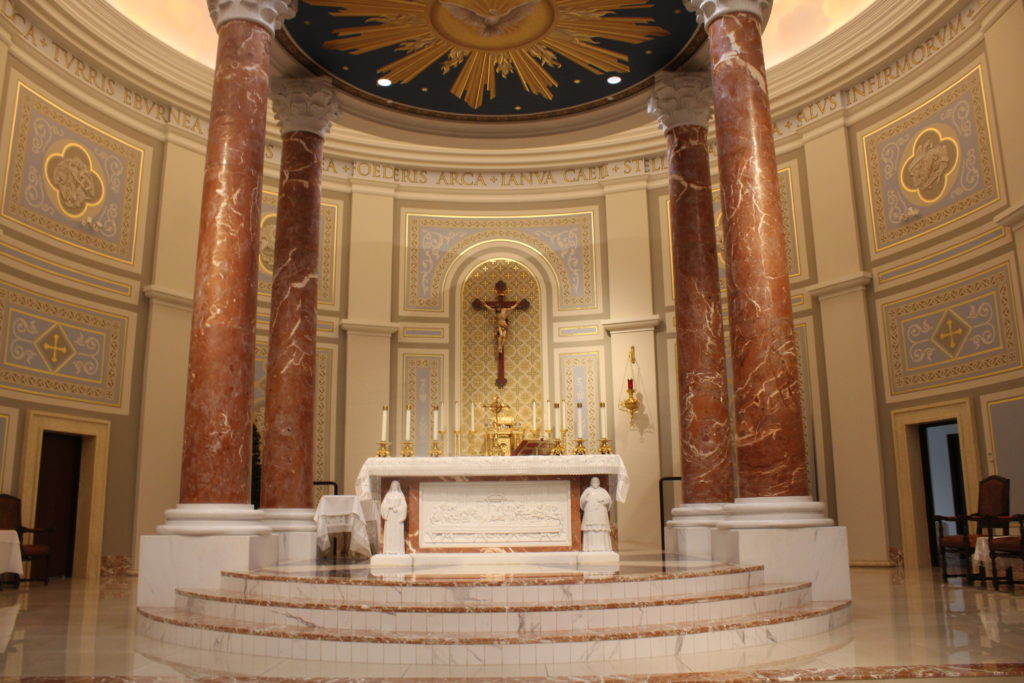
Evangelistic impact
Paul Zucarelli and his wife travel half an hour from Fountain Hills every Sunday because of the beauty of the church.
“I just think of all the people that will be saved here and find Jesus with the sacraments long after I’m dead, [and] all the future generations that will come to know Christ because of this beautiful church,” he said.
Dcn. Auriemma said the effects the new art has on people is at the “heart of evangelization” and serves as a catechetical tool for Catholics.
“Above all, it’s the sense of returning to true beauty as being the portal to the divine — the gateway to encountering God,” he said. “The beauty here in this church speaks for itself.”
Quoting the philosopher Plato in his homily, Bishop Olmsted said that “beauty is the splendor of truth” that inspires goodness and love.
“May St. Bernadette’s Parish, and the beauty of this church and organ, together with the virtuous lives of its parishioners, bring many people to discover and rejoice in the wondrous beauty of God, found most fully in Jesus, our Lord.”





